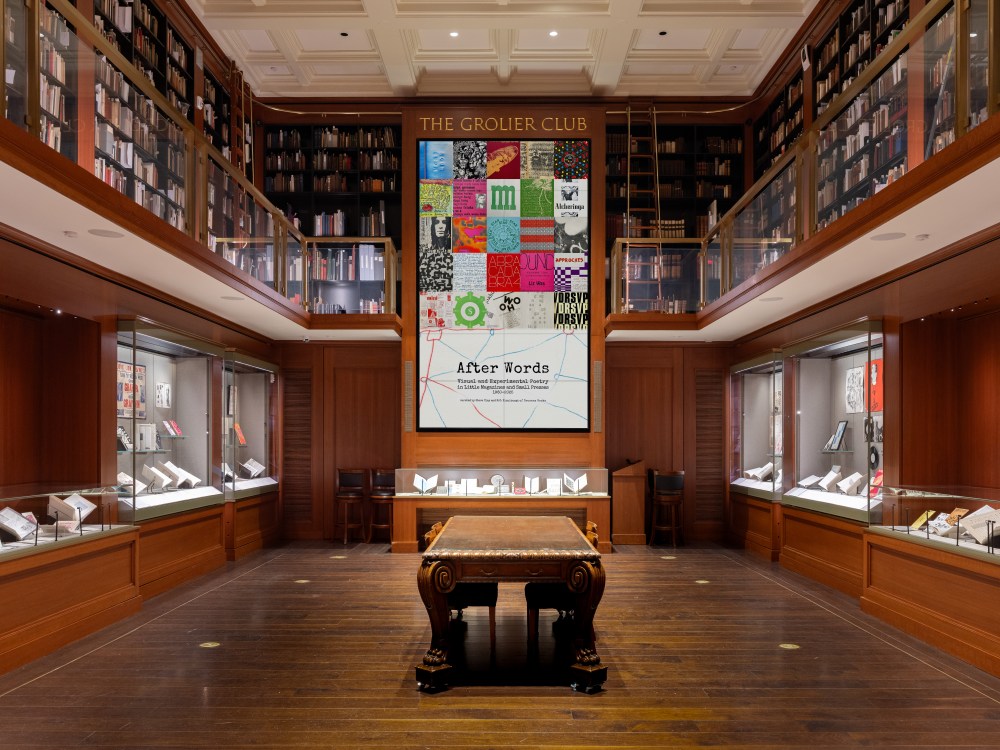Visual, concrete and sound poetry reached new heights of innovation in the 1960s—and The Grolier Club is the place for classic, post-classic and contemporary experimental books and periodicals. On view until July 26, After Words: Visual and Experimental Poetry in Little Magazines and Small Presses, 1960–2025, highlights more than 130 works of visual poetry published by artist-run presses and small magazines during the mimeograph revolution. They trace many forms of experimental poetics, including cut-up, collage, sound poetry scores, performance scripts, practices of “writing through,” erasure, asemic writing, glyph systems, calligraphy, experimental typography, non-Western alphabets, assemblages, and beyond.
The collection belongs to Steve Clay, and an accompanying catalog is available from his Granary Books, a leading indie imprint.
(Images and captions below courtesy The Grolier Club.)
Wallace Berman. [Untitled: Opt.82. Booster Bng. Anguinea / Y]. John Martin, 1967.
This poster/poem by Berman was published by John Martin of Black Sparrow Press. Berman was known for his Verifax collages, which incorporated the Hebrew alphabet and evoked Kabbalistic elements, often with the same repeating motif of a hand holding a radio, upon which other images are projected.
Ian Hamilton Finlay. Sea-Poppy 2 (Fishing Boat Names). Wild Hawthorn Press, 1968.
Ian Hamilton Finlay’s Wild Hawthorn Press (founded in 1961) provided a platform for his work with a wide range of collaborating artists, photographers, printers, calligraphers and designers, encompassing books and booklets, cards and folding cards, poems/prints, proposals, and other publications.
d.a. levy. The Tibetan Stroboscope. Ayizan Press, 1968.
d.a. levy has said that The Tibetan Stroboscope is “an experiment in Destructive Writing ‘other’ communications and ‘concrete’ prose piece | peace & awareness.” The work was published on newsprint.
Shoji Yoshizawa, ed. Shi Shi: Concrete & Visual Poetry, no. 2. May 1981.
Shoji Yoshizawa edited Shi Shi from 1981 to 1993. One of his areas of focus for his practice was the exploration of Kanji characters and their potential for abstraction into sculptural forms.
[mIEKAL aND]. BABBALLY. Burning Press, 1990.
This monumental poster contains a long poem subtitled “The Destruction of Mindfuck Diplomacy.” According to author aND, “BABBALLY is a serial poem of voices interacting in global neologism,” written prior to the birth of his and Elizabeth Was’ child.
bill bissett. Lunaria. Granary Books, 2001.
This book explores bissett’s “home planet,” named Lunaria, and includes sights and experiences from “les moon rayze” to “happeeness in ths short life” that are woven into expressive drawings and explorations of language.
Harry Smith collage. Fruit Cup, no. 0. Mary Beach, ed. Beach Books, Texts, & Documents Inc., 1969.
This was a “one-shot” little magazine, published only as a single volume, by collage artist Mary Beach and featuring many contributors associated with the Beats. Pictured is a collage by Harry Smith, with photos by Frank Burke, that showcase Smith’s interest in the ephemeral form of “string figures,” or shapes made from loops of string.
The post The Daily Heller: Wake Up! For the Sleeper Show of the Season at the Grolier appeared first on PRINT Magazine.

